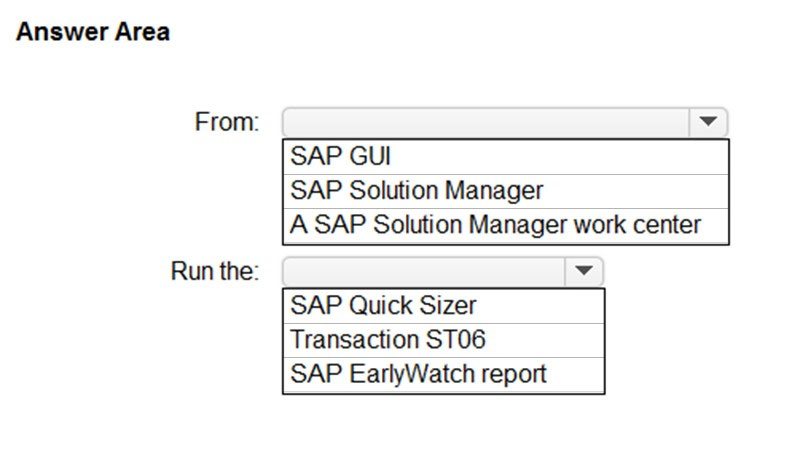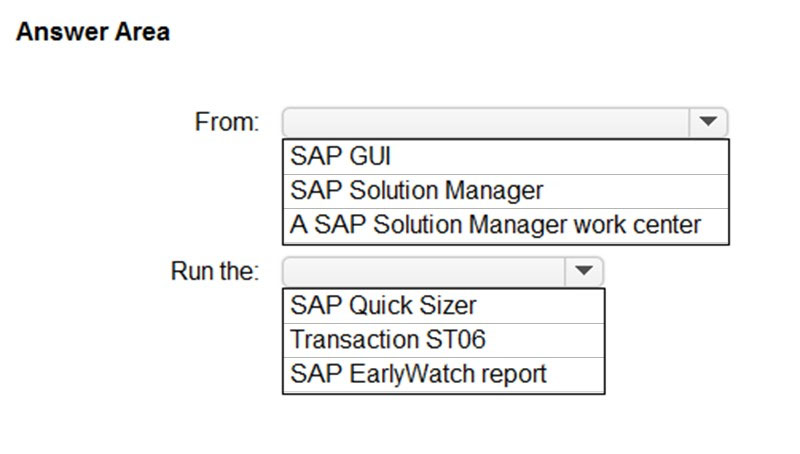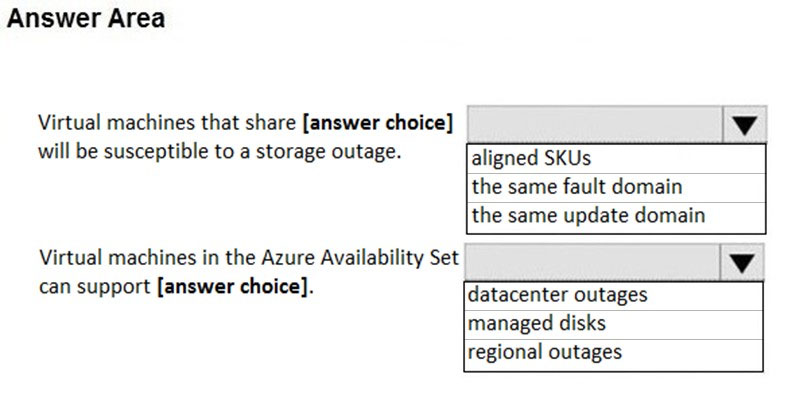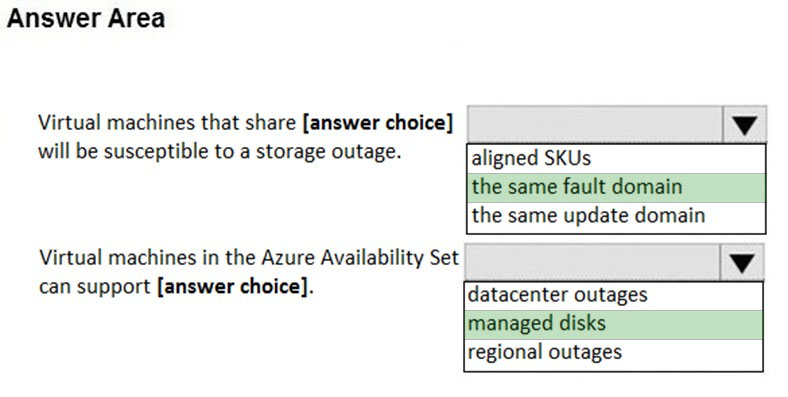Microsoft AZ-120 Exam Practice Questions (P. 5)
- Full Access (284 questions)
- Six months of Premium Access
- Access to one million comments
- Seamless ChatGPT Integration
- Ability to download PDF files
- Anki Flashcard files for revision
- No Captcha & No AdSense
- Advanced Exam Configuration
Question #21
HOTSPOT -
You have an on-premises deployment of SAP HANA.
You plan to migrate the deployment to Azure.
You need to identify the following from the last six months:
✑ The number of active users
✑ The database performance
What should you do? To answer, select the appropriate options in the answer area.
NOTE: Each correct selection is worth one point.
Hot Area:

You have an on-premises deployment of SAP HANA.
You plan to migrate the deployment to Azure.
You need to identify the following from the last six months:
✑ The number of active users
✑ The database performance
What should you do? To answer, select the appropriate options in the answer area.
NOTE: Each correct selection is worth one point.
Hot Area:

Correct Answer:

Reference:
https://assets.cdn.sap.com/sapcom/docs/2019/09/0e8d0628-687d-0010-87a3-c30de2ffd8ff.pdf

Reference:
https://assets.cdn.sap.com/sapcom/docs/2019/09/0e8d0628-687d-0010-87a3-c30de2ffd8ff.pdf
send
light_mode
delete
Question #22
You have an SAP environment on Azure that uses multiple subscriptions.
To meet GDPR requirements, you need to ensure that virtual machines are deployed only to the West Europe and North Europe Azure regions.
Which Azure components should you use?
To meet GDPR requirements, you need to ensure that virtual machines are deployed only to the West Europe and North Europe Azure regions.
Which Azure components should you use?
- AAzure resource locks and the Compliance admin center
- BAzure resource groups and role-based access control (RBAC)
- CAzure management groups and Azure PolicyMost Voted
- DAzure Security Center and Azure Active Directory (Azure AD) groups
Correct Answer:
C
Azure Policy enables you to set policies to conform to the GDPR. Azure Policy is generally available today at no additional cost to Azure customers. You can use
Azure Policy to define and enforce policies that help your cloud environment become compliant with internal policies as well as external regulations.
Azure Policy is deeply integrated into Azure Resource Manager and applies across all resources in Azure. Individual policies can be grouped into initiatives to quickly implement multiple rules. You can also use Azure Policy in a wide range of compliance scenarios, such as ensuring that your data is encrypted or remains in a specific region as part of GDPR compliance. Microsoft is the only hyperscale cloud provider to offer this level of policy integration built in to the platform for no additional charge.
References:
https://azure.microsoft.com/de-de/blog/new-capabilities-to-enable-robust-gdpr-compliance/
C
Azure Policy enables you to set policies to conform to the GDPR. Azure Policy is generally available today at no additional cost to Azure customers. You can use
Azure Policy to define and enforce policies that help your cloud environment become compliant with internal policies as well as external regulations.
Azure Policy is deeply integrated into Azure Resource Manager and applies across all resources in Azure. Individual policies can be grouped into initiatives to quickly implement multiple rules. You can also use Azure Policy in a wide range of compliance scenarios, such as ensuring that your data is encrypted or remains in a specific region as part of GDPR compliance. Microsoft is the only hyperscale cloud provider to offer this level of policy integration built in to the platform for no additional charge.
References:
https://azure.microsoft.com/de-de/blog/new-capabilities-to-enable-robust-gdpr-compliance/
send
light_mode
delete
Question #23
HOTSPOT -
You have an Azure Availability Set that is configured as shown in the following exhibit.

Use the drop-down menus to select the answer choice that completes each statement based on the information presented in the graphic.
NOTE: Each correct selection is worth one point.
Hot Area:

You have an Azure Availability Set that is configured as shown in the following exhibit.

Use the drop-down menus to select the answer choice that completes each statement based on the information presented in the graphic.
NOTE: Each correct selection is worth one point.
Hot Area:

Correct Answer:

Box 1: the same fault domain -
Fault domains define the group of virtual machines that share a common power source and network switch. If a storage fault domain fails due to hardware or software failure, only the VM instance with disks on the storage fault domain fails.
Box 2: managed disks -
Managed disks provide better reliability for Availability Sets by ensuring that the disks of VMs in an Availability Set are sufficiently isolated from each other to avoid single points of failure. It does this by automatically placing the disks in different storage fault domains (storage clusters) and aligning them with the VM fault domain.
References:
https://docs.microsoft.com/en-us/azure/virtual-machines/windows/manage-availability

Box 1: the same fault domain -
Fault domains define the group of virtual machines that share a common power source and network switch. If a storage fault domain fails due to hardware or software failure, only the VM instance with disks on the storage fault domain fails.
Box 2: managed disks -
Managed disks provide better reliability for Availability Sets by ensuring that the disks of VMs in an Availability Set are sufficiently isolated from each other to avoid single points of failure. It does this by automatically placing the disks in different storage fault domains (storage clusters) and aligning them with the VM fault domain.
References:
https://docs.microsoft.com/en-us/azure/virtual-machines/windows/manage-availability
send
light_mode
delete
Question #24
A customer that has a large enterprise SAP environment plans to migrate to Azure. The environment uses servers that run Windows Server 2016 and Microsoft
SQL Server.
The environment is critical and requires a comprehensive business continuity and disaster recovery (BCDR) strategy that minimizes the recovery point objective
(RPO) and the recovery time objective (RTO).
The customer wants a resilient environment that has a secondary site that is at least 250 kilometers away.
You need to recommend a solution for the customer.
Which two solutions should you recommend? Each correct answer presents part of the solution.
NOTE: Each correct selection is worth one point.
SQL Server.
The environment is critical and requires a comprehensive business continuity and disaster recovery (BCDR) strategy that minimizes the recovery point objective
(RPO) and the recovery time objective (RTO).
The customer wants a resilient environment that has a secondary site that is at least 250 kilometers away.
You need to recommend a solution for the customer.
Which two solutions should you recommend? Each correct answer presents part of the solution.
NOTE: Each correct selection is worth one point.
- Awarm standby virtual machines in paired regionsMost Voted
- BAzure Traffic Manager to route incoming trafficMost Voted
- Cwarm standby virtual machines in an Azure Availability Set that uses geo-redundant storage (GRS)
- Dan internal load balancer to route Internet traffic
- Ewarm standby virtual machines in Azure Availability Zones
Correct Answer:
AC
A: An Azure Region Pair is a relationship between two Azure Regions within the same geographic region for disaster recovery purposes. If one of the regions were to experience a disaster or failure, then the services in that region will automatically failover to that regions secondary region in the pair.
C: For increased availability, you can deploy two VMs with two HANA instances within an Azure availability set that uses HANA system replication for availability.
References:
https://docs.microsoft.com/en-us/azure/virtual-machines/workloads/sap/sap-hana-availability-one-region
AC
A: An Azure Region Pair is a relationship between two Azure Regions within the same geographic region for disaster recovery purposes. If one of the regions were to experience a disaster or failure, then the services in that region will automatically failover to that regions secondary region in the pair.
C: For increased availability, you can deploy two VMs with two HANA instances within an Azure availability set that uses HANA system replication for availability.
References:
https://docs.microsoft.com/en-us/azure/virtual-machines/workloads/sap/sap-hana-availability-one-region
send
light_mode
delete
Question #25
You plan to deploy an SAP environment on Azure that will use Azure Availability Zones.
Which load balancing solution supports the deployment?
Which load balancing solution supports the deployment?
- AAzure Basic Load Balancer
- BAzure Standard Load Balancer
- CAzure Application Gateway v1 SKU
Correct Answer:
B
When you deploy Azure VMs across Availability Zones and establish failover solutions within the same Azure region, some restrictions apply:
✑ You can't use an Azure Basic Load Balancer to create failover cluster solutions based on Windows Server Failover Clustering or Linux Pacemaker. Instead, you need to use the Azure Standard Load Balancer SKU.
References:
https://docs.microsoft.com/en-us/azure/virtual-machines/workloads/sap/sap-ha-availability-zones
B
When you deploy Azure VMs across Availability Zones and establish failover solutions within the same Azure region, some restrictions apply:
✑ You can't use an Azure Basic Load Balancer to create failover cluster solutions based on Windows Server Failover Clustering or Linux Pacemaker. Instead, you need to use the Azure Standard Load Balancer SKU.
References:
https://docs.microsoft.com/en-us/azure/virtual-machines/workloads/sap/sap-ha-availability-zones
send
light_mode
delete
All Pages
